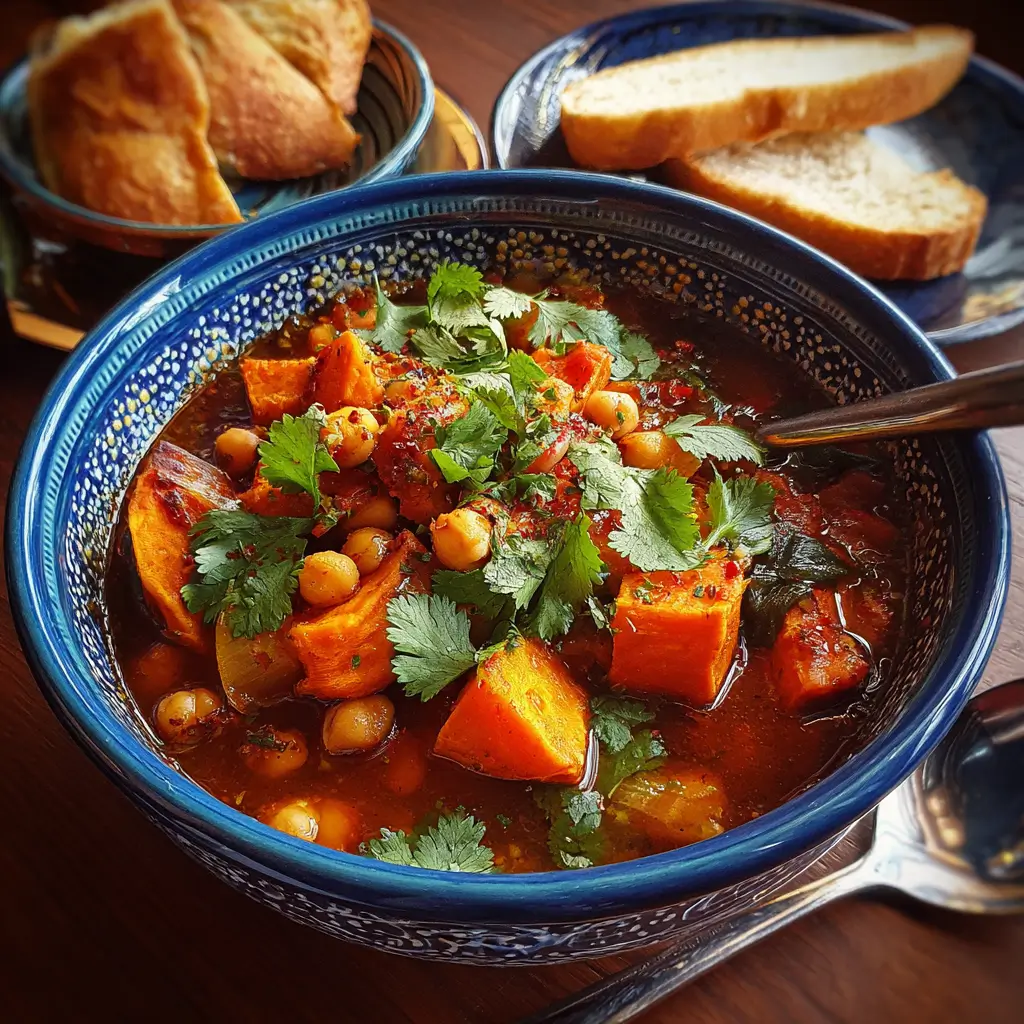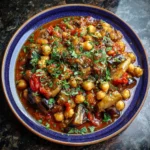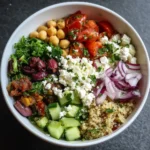Moroccan Chickpea and Sweet Potato Tagine: A Flavorful Journey Through North African Cuisine
The History of Tagine: A Culinary Heritage from Morocco
The tagine is more than just a dish—it’s a cultural symbol deeply rooted in Moroccan tradition. Originating from North Africa, particularly Morocco, the tagine takes its name from the earthenware cooking vessel it’s traditionally prepared in. This conical clay pot has been used for centuries across Berber, Arab, and Andalusian communities to slow-cook stews over open flames or charcoal. The unique design of the tagine—its wide base and tapered lid—allows steam to circulate and condense, returning moisture to the ingredients, resulting in tender, flavorful meals with minimal added liquid.
Historically, tagines were central to communal dining in Moroccan households, often shared among families during Friday lunches or festive occasions like Eid and Ramadan. The combination of sweet and savory elements reflects the rich spice trade history of Morocco, where merchants brought saffron, cinnamon, ginger, and other exotic spices from as far as India and sub-Saharan Africa. Over time, the chickpea and sweet potato variation emerged as a beloved vegetarian option, especially popular during fasting periods or among those seeking hearty plant-based meals. Today, this dish transcends borders, celebrated globally for its depth of flavor, nutritional balance, and soul-warming comfort.
Ingredients Breakdown: Understanding the Flavors of Morocco
The magic of Moroccan chickpea and sweet potato tagine lies in its harmonious blend of earthy vegetables, aromatic spices, and subtle sweetness. Each ingredient plays a crucial role in building layers of flavor that define authentic Maghrebi cuisine.
- Sweet Potatoes: These vibrant orange tubers add natural sweetness, creaminess, and a wealth of beta-carotene. Their soft texture when cooked complements the heartiness of chickpeas.
- Chickpeas (Garbanzo Beans): Whether canned or dried and soaked, chickpeas are the protein-rich backbone of the dish. They absorb the spiced broth beautifully while maintaining a satisfying bite.
- Onions and Garlic: The aromatic foundation. Slowly caramelized onions bring depth and mild sweetness, while garlic adds pungency and complexity.
- Fresh Ginger and Turmeric: Freshly grated ginger offers warmth and zing, while turmeric contributes both color and anti-inflammatory properties.
- Tomatoes: Diced tomatoes (canned or fresh) provide acidity and body to the sauce, helping balance the richness of the spices.
- Spices – Cumin, Coriander, Cinnamon, Paprika, Cayenne: This quintet forms the soul of the tagine. Cumin brings earthiness, coriander adds citrusy notes, cinnamon imparts warmth and sweetness, paprika deepens color, and cayenne introduces gentle heat.
- Vegetable Broth: Acts as the cooking medium, infusing all ingredients with savory umami. Homemade broth enhances flavor, but store-bought works well too.
- Lemon Juice and Zest: Brightens the entire dish, cutting through the richness and enhancing the perception of freshness.
- Olives and Preserved Lemons (Optional but Traditional): These add a distinctive tangy-salty note characteristic of North African cooking. Green olives contribute brininess, while preserved lemons offer an intense citrus punch.
- Honey or Maple Syrup: A touch of sweetness balances the spices and enhances the natural sugars in the sweet potatoes.
- Olive Oil: Used for sautéing, it lends fruitiness and helps bloom the spices properly.
- Fresh Herbs – Cilantro and Parsley: Added at the end, these herbs elevate the aroma and provide a burst of freshness.
Step-by-Step Recipe: How to Make Authentic Moroccan Chickpea and Sweet Potato Tagine
Follow this detailed guide to create a fragrant, comforting tagine that captures the essence of Moroccan home cooking—even if you don’t have a traditional clay pot!
Preparation Time:
15 minutes
Cooking Time:
45–60 minutes
Servings:
4–6 people
Ingredients:
- 2 tablespoons extra-virgin olive oil
- 1 large yellow onion, finely chopped
- 4 cloves garlic, minced
- 1 tablespoon fresh ginger, grated
- 2 medium sweet potatoes (about 600g), peeled and cut into 1-inch cubes
- 1 teaspoon ground cumin
- 1 teaspoon ground coriander
- 1 teaspoon ground cinnamon
- 1/2 teaspoon smoked paprika
- 1/4 teaspoon cayenne pepper (adjust to taste)
- 1/2 teaspoon ground turmeric
- 1 can (14 oz / 400g) diced tomatoes (with juice)
- 2 cans (15 oz / 425g each) chickpeas, drained and rinsed
- 2 cups (480ml) vegetable broth
- 1 tablespoon maple syrup or honey
- 1 tablespoon lemon juice (plus zest of 1 lemon)
- 1/2 cup green olives, pitted and halved (optional)
- 2 tablespoons preserved lemon, finely chopped (optional)
- Salt and freshly ground black pepper, to taste
- 1/4 cup fresh cilantro, chopped
- 1/4 cup fresh parsley, chopped
Directions:
- Sauté the Aromatics: In a large heavy-bottomed pot or Dutch oven, heat the olive oil over medium heat. Add the chopped onion and cook for 5–7 minutes until softened and lightly golden. Stir in the garlic and grated ginger, cooking for another minute until fragrant.
- Bloom the Spices: Add all the dry spices—cumin, coriander, cinnamon, paprika, cayenne, and turmeric. Stir constantly for about 30 seconds to toast the spices, releasing their essential oils and deepening their flavor. Be careful not to burn them.
- Add Sweet Potatoes: Stir in the cubed sweet potatoes, coating them evenly with the spiced onion mixture. Cook for 2–3 minutes to sear slightly and enhance flavor development.
- Incorporate Tomatoes and Chickpeas: Pour in the diced tomatoes with their juice, followed by the drained chickpeas. Mix well to combine, allowing the ingredients to simmer together for 3–4 minutes.
- Pour in Broth and Simmer: Add the vegetable broth, maple syrup (or honey), lemon juice, salt, and pepper. Bring the mixture to a gentle boil, then reduce the heat to low. Cover and let it simmer for 30–40 minutes, stirring occasionally, until the sweet potatoes are fork-tender and the sauce has thickened into a rich stew.
- Final Touches: Taste and adjust seasoning. Stir in the green olives and preserved lemon (if using). Sprinkle in the fresh lemon zest for brightness. Remove from heat.
- Garnish and Serve: Fold in most of the chopped cilantro and parsley, reserving some for garnish. Serve hot, ideally over couscous, quinoa, or crusty bread to soak up the luscious sauce.
Tips for Perfect Tagine Every Time
- Low and Slow is Key: Allow the tagine to simmer gently. Rushing the process may result in undercooked sweet potatoes or a thin sauce. If needed, extend cooking time by 10–15 minutes.
- Bloom Spices Properly: Toasting spices in oil activates their volatile compounds, unlocking deeper flavors. Don’t skip this step!
- Use Preserved Lemons for Authenticity: While optional, preserved lemons are a hallmark of Moroccan cuisine. You can find them in Middle Eastern markets or make your own at home with lemons, salt, and time.
- Balance Sweet and Savory: Adjust the amount of honey or maple syrup based on the natural sweetness of your sweet potatoes and tomatoes. Too much sugar can overpower the spices.
- Thicken the Sauce: If the tagine turns out too watery, remove the lid during the last 10 minutes of cooking to allow excess liquid to evaporate. Alternatively, mash a few chickpeas against the side of the pot to naturally thicken the stew.
- Make It Ahead: Like many stews, this tagine tastes even better the next day as the flavors continue to meld. Reheat gently on the stove with a splash of water or broth.
- Don’t Overcook the Chickpeas: Since canned chickpeas are already cooked, adding them later prevents mushiness. If using dried chickpeas, ensure they’re fully tender before adding to the pot.
Variations and Customizations: Make It Your Own
One of the beauties of tagine is its adaptability. Feel free to experiment with seasonal produce, proteins, and regional twists:
- Add More Vegetables: Carrots, zucchini, bell peppers, eggplant, or butternut squash pair wonderfully with the existing flavors.
- Include Protein: Add grilled chicken, lamb, or shrimp for a non-vegetarian version. For vegans, try tofu or tempeh marinated in Moroccan spices.
- Grain-Free Option: Serve over cauliflower rice or roasted turnips instead of couscous.
- Gluten-Free Friendly: Naturally gluten-free, just double-check labels on broth and preserved lemons.
- Spice Level Control: Omit cayenne for a mild dish, or add harissa paste for extra North African heat.
- Dried Fruit Twist: Stir in raisins, apricots, or dates during the last 10 minutes of cooking for a sweeter profile reminiscent of royal palace recipes.
- Creamy Finish: Swirl in a spoonful of plain yogurt or coconut milk before serving for added richness.
- Smoky Flavor Boost: Use fire-roasted tomatoes or add a pinch of smoked paprika for a deeper smokiness.
Health Considerations and Nutritional Value
Moroccan chickpea and sweet potato tagine isn’t just delicious—it’s also incredibly nutritious, making it a standout choice for health-conscious eaters and those following plant-based diets.
Nutritional Highlights (per serving, approx. 1.5 cups, serves 6):
- Calories: ~280–320 kcal
- Protein: 10–12g (from chickpeas and vegetables)
- Fiber: 9–11g (supports digestion and satiety)
- Complex Carbohydrates: From sweet potatoes and chickpeas, providing sustained energy
- Healthy Fats: Monounsaturated fats from olive oil support heart health
- Vitamin A: Extremely high due to beta-carotene in sweet potatoes—essential for vision and immune function
- Vitamin C: From tomatoes, lemon, and herbs—boosts immunity and collagen production
- Iron and Folate: Abundant in chickpeas, important for red blood cell formation and DNA synthesis
- Antioxidants: Spices like turmeric (curcumin), cinnamon, and cumin have potent anti-inflammatory effects
Health Benefits:
- Supports Gut Health: High fiber content promotes a healthy microbiome and regular bowel movements.
- Blood Sugar Regulation: Despite the natural sugars, the fiber and complex carbs help maintain steady glucose levels—ideal for diabetics when portion-controlled.
- Heart Healthy: Low in saturated fat and rich in potassium (from sweet potatoes), which helps regulate blood pressure.
- Weight Management: Satiating and nutrient-dense without being calorie-dense, perfect for balanced meals.
- Anti-Inflammatory Properties: Thanks to spices like turmeric and ginger, this dish may help reduce chronic inflammation.
Dietary Notes:
- Perfect for vegan, vegetarian, gluten-free, and dairy-free diets
- Can be adapted for nut-free and soy-free lifestyles
- Rich in plant-based protein and iron—great for meatless Mondays or full-time plant-based eating
Frequently Asked Questions (FAQ)
Can I make this tagine in a slow cooker?
Absolutely! After sautéing the aromatics and blooming the spices on the stove, transfer everything to a slow cooker. Add the remaining ingredients (except fresh herbs and lemon zest) and cook on LOW for 6–8 hours or HIGH for 3–4 hours. Stir in herbs and zest before serving.
What can I use instead of preserved lemon?
If unavailable, substitute with 1 teaspoon lemon zest + 1 tablespoon lemon juice. However, preserved lemon has a unique salty-tangy depth that’s hard to replicate exactly.
Is this dish freezer-friendly?
Yes! Cool completely and store in airtight containers for up to 3 months. Thaw overnight in the fridge and reheat on the stove with a splash of broth.
Can I use dried chickpeas instead of canned?
Definitely. Soak 1 cup dried chickpeas overnight, then boil until tender (about 1–1.5 hours) before adding them to the tagine. Reduce broth slightly since dried beans absorb more liquid.
Do I need a tagine pot to make this dish?
No. While traditional, any heavy pot with a tight-fitting lid—like a Dutch oven or deep skillet—works perfectly. Just mimic the slow-cooking method.
How do I prevent the sweet potatoes from turning mushy?
Cut them into uniform, slightly larger cubes and avoid overcooking. Check for doneness around 30 minutes; they should be tender but still hold shape.
Can I make this oil-free?
Yes, for an oil-free version, sauté onions and spices in a bit of vegetable broth or water. The flavor will be lighter but still satisfying.
What should I serve with tagine?
Classic pairings include fluffy couscous, quinoa, bulgur, or crusty bread. A side of harissa, tzatziki, or plain yogurt complements the spices well. Add a simple salad of cucumber, tomato, and red onion dressed with lemon and olive oil for freshness.
Summary
Moroccan chickpea and sweet potato tagine is a nourishing, aromatic stew that blends sweet and savory flavors with warming spices, offering a taste of North African heritage in every bite. Hearty, healthy, and endlessly customizable, it’s a perfect one-pot meal for weeknights, gatherings, or meal prep.










